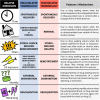Common neurocircuitry mediating drug and fear relapse in preclinical models
- PMID: 30255379
- PMCID: PMC6373193
- DOI: 10.1007/s00213-018-5024-3
Common neurocircuitry mediating drug and fear relapse in preclinical models
Abstract
Background: Comorbidity of anxiety disorders, stressor- and trauma-related disorders, and substance use disorders is extremely common. Moreover, therapies that reduce pathological fear and anxiety on the one hand, and drug-seeking on the other, often prove short-lived and are susceptible to relapse. Considerable advances have been made in the study of the neurobiology of both aversive and appetitive extinction, and this work reveals shared neural circuits that contribute to both the suppression and relapse of conditioned responses associated with trauma or drug use.
Objectives: The goal of this review is to identify common neural circuits and mechanisms underlying relapse across domains of addiction biology and aversive learning in preclinical animal models. We focus primarily on neural circuits engaged during the expression of relapse.
Key findings: After extinction, brain circuits involving the medial prefrontal cortex and hippocampus come to regulate the expression of conditioned responses by the amygdala, bed nucleus of the stria terminalis, and nucleus accumbens. During relapse, hippocampal projections to the prefrontal cortex inhibit the retrieval of extinction memories resulting in a loss of inhibitory control over fear- and drug-associated conditional responding.
Conclusions: The overlapping brain systems for both fear and drug memories may explain the co-occurrence of fear and drug-seeking behaviors.
Keywords: Addiction; Amygdala; Bed nucleus of the stria terminalis; Extinction; Hippocampus; PTSD; Prefrontal cortex; Reinstatement; Relapse.
Figures


References
-
- Almada RC, Coimbra NC, Brandão ML. Medial prefrontal cortex serotonergic and GABAergic mechanisms modulate the expression of contextual fear: intratelencephalic pathways and differential involvement of cortical subregions. Neuroscience. 2015;284:988–997. doi: 10.1016/j.neuroscience.2014.11.001. - DOI - PubMed
Publication types
MeSH terms
Grants and funding
LinkOut - more resources
Full Text Sources
Other Literature Sources
Medical

